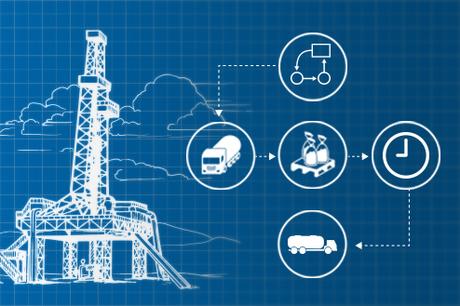 Imagine you’re four weeks into drilling a well and you need the next delivery of casing. At most well sites, that means calling the carrier to have casing delivered that same day. Problem is, same-day delivery can increase shipping costs up to 30 percent. The added cost is an overthought, though, because that’s the way it’s always been done.
Imagine you’re four weeks into drilling a well and you need the next delivery of casing. At most well sites, that means calling the carrier to have casing delivered that same day. Problem is, same-day delivery can increase shipping costs up to 30 percent. The added cost is an overthought, though, because that’s the way it’s always been done.
What if casing, separators, sand or other materials were slated to arrive on a set schedule? No calls for costly same-day shipments, and production stays on track.
That’s the premise of a “Plan for Every Well.”
When oil was $100 a barrel, some oil and gas companies weren’t concerned with shaving percentages or saving dollars. With a barrel hovering near $50, volatility in the oil and gas industry has led to increased need for cost-saving measures. For some, savings begins at the well field, or – more precisely – on the delivery truck.
Ryder recently partnered with a large Exploration and Production company to examine logistics at 130 unconventional well sites during a three-year period. It was found that the six major well components – drill pipe, casing, tanks, separators, meter skids, and hookups – accounted for 80 percent of drilling and completion freight transportation charges. Coincidentally, 80 percent of the time, the day these six components are needed onsite can be reasonably predicted, with an average time frame starting one week prior to spud date and ending seven weeks after.
In practice, however, these materials generally are ordered with less than six hours lead time, often in the morning for afternoon delivery. The result is dramatically increased transportation charges. The rationale often is the same: “We can never plan for when materials will be needed.”
Research proves you can. By putting in place a transportation plan, or a “Plan for Every Well,” site managers can better manage product requirements to delivery schedules.
Similar to value stream mapping, well planning dissects the equipment needed and the anticipated schedule to improve alignment with the supply chain.
For example, it’s known that casing, tanks and diesel are needed at least a week before spud date. The week of spud date, almost all materials are needed on site. By seven weeks, tubing and hook-ups are needed. Diesel is needed with some predictability throughout the schedule.
By implementing a plan, the well site manager can replace same-day ordering with a standing order based on 24 to 48 hours’ lead time.
With this strategic planning discipline, transportation costs can be reduced by as much as 30 percent. What’s more, better planning can ensure more efficient and optimized loads.
This also removes pressure from the logistics provider. With too short lead time, the 3PL provider might be left to engage a less preferred carrier to make the delivery, further raising costs and increasing safety risk.
Done correctly, the plan becomes part of a delivery schedule on a calendaring application with a similar look and feel as Microsoft Outlook. At a glance, a manager can ensure the schedule matches the project’s progress. It becomes part of the workflow, instead of a phone call in a pinch.
That said, no plan is set in stone. If well production is faster or slower than anticipated, shipments can be adjusted.
By drafting and implementing a better transportation or logistics plan, companies can maximize potential savings, while still remaining agile as conditions change. Though transportation is a minor cost comparatively speaking in well production, saving 30 percent could translate to tens of millions of dollars.
Oil and gas exploration is a sophisticated industry. Logistics shouldn’t be the weak link. By working with your 3PL partner, your organization can analyze the data and craft a “Plan for Every Well” that delivers a more holistic view of logistics, more timely product delivery, and better savings to the bottom line.
Written by Will Taylor
Will Taylor is Senior Director of Engineering in the Oil & Gas Solutions group at Ryder. Having worked in the transportation for 21 years, Taylor views the industry as a puzzle where the right solution can help customers realize value in safety, service and savings, and over the years has helped create logistics solutions for large, complex companies by leveraging data, process, and optimization.

